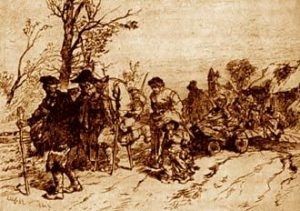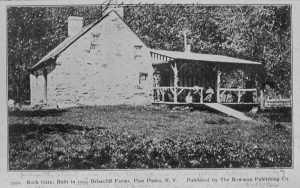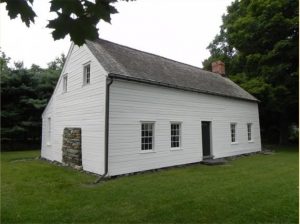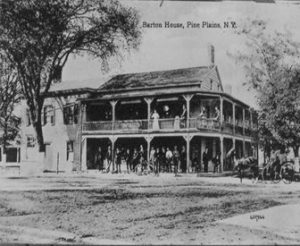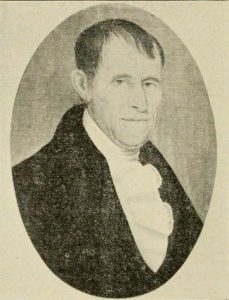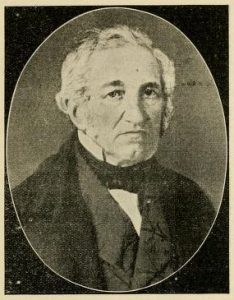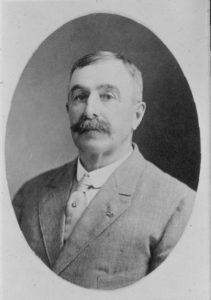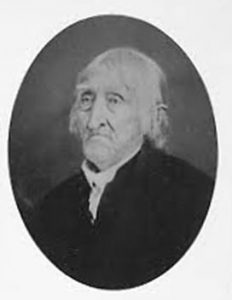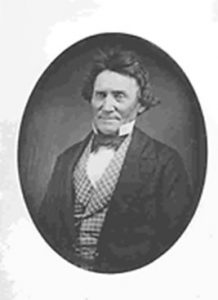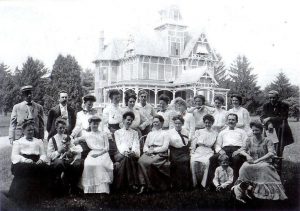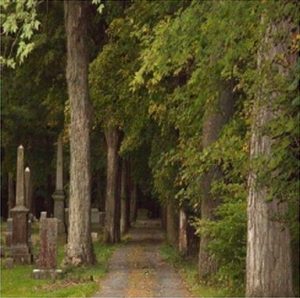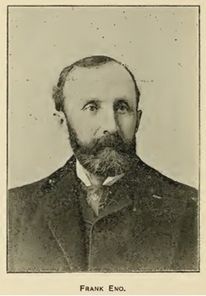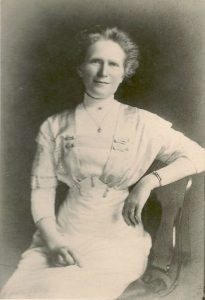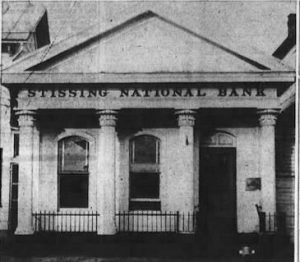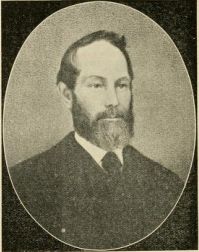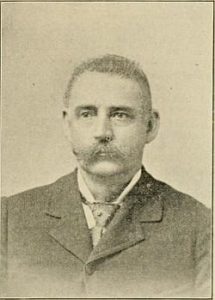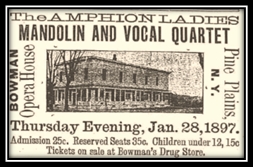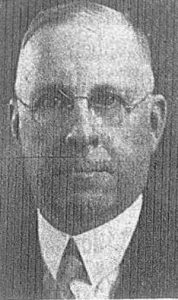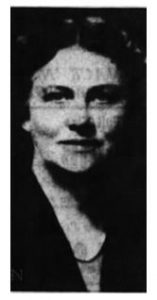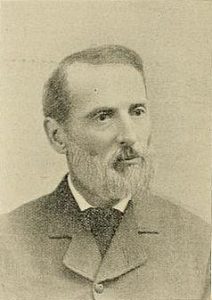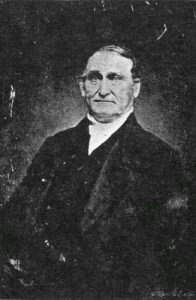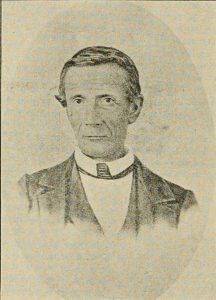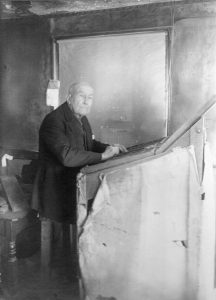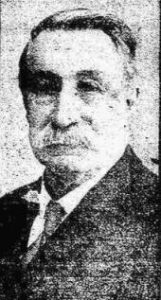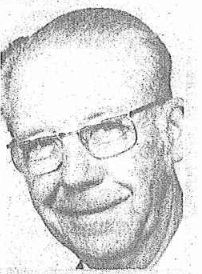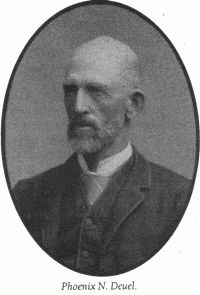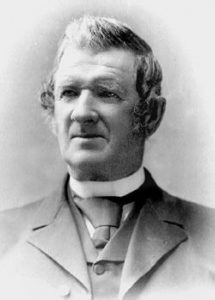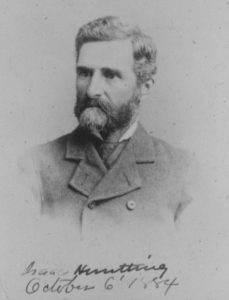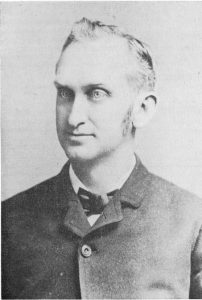The following were some of the leading players in the development of Pine Plains, as well as other interesting folk, from the time of the granting of the Little Nine Partners Patent in 1706 through the early years of the 20th century. Note: information on additional people can be found on other pages.
Native Americans
The Mahicans were a confederacy of five Algonkian-speaking tribes and northern Dutchess County would have been the extreme southern range of their territory, the Roeliff-Jansen Kill making a convenient natural boundary with the Wappingers, their close relatives to the south. Because of its location, the village of Shekomeko was composed of members of various tribes and therefore a "mixed community", although Schaghticoke-Mahicans were the most numerous and the dominating influence.
Wasamapah, called Tschoop (?-1746): A Mahican "owl" (the chief's right hand man and advisor) from the village of Shekomeko who became one of the “first fruits” (first converts) at the Moravian mission here. He was baptized Johannes (John) on April 16, 1742 and became an evangelist among his people. His wife's name was Martha. Due to some injury he was lame, and he is believed to be the model for Chingachgook in James Fenimore Cooper’s “The Last of the Mohicans”. He died of smallpox in 1746 in Bethlehem, Pennsylvania. His acceptance of the missionaries was instrumental in the (albeit short-lived) success of the mission (see "The Moravian Mission at Shekomeko" page).
Mannessah (ca. 1770-?): A renowned local medicine man, thought to be the son of Shekomeko Indians. He was the last Native American resident of Gallatin in Columbia County, living about a half mile north of Hoffman's Mill, later relocating to Michigan. For more on Mannessah, please visit Brian Altonen's website.
Joanna: lived about a mile north of Hoffman's Mill in a house near the dwelling of Isaac B. Smith, Esq. She was said to be a descendant of the Shekomeko Indians.
Sources and Suggested Further Reading:
Palatines
The Palatines were from the Palatinate of Germany, who first came to England as refugees, fleeing famine, war, and religious persecution in their homeland. In 1710 about 3,000 were sent over to the Hudson Valley in New York to work on the production of naval stores (resin-based products of the pitch pine tree that were used in the shipping industry). They were divided into West Camp on the west side of the Hudson River (roughly where Saugerties is today) and East Camp on the east side (where Germantown is today). They were pretty much indentured servants, expected to work to pay for their passage.
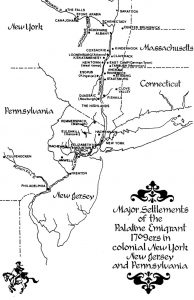
However, the venture was a complete failure and was halted in 1712, leaving the Palatines to fend for themselves. About 850 families disbursed throughout the region, with some finding their way to the area that would become Pine Plains. They were among the first white settlers here. Note "Stissing" on the map (see inset).
John (Johannes) Rau (1696-1768) and Michael Rowe (?-1783): It is thought that they were brothers. Documentation shows that John (not to be confused with John Rowe of Milan, his son) was born in Germany and came with his father to this country as a youth at the time of the Palatine migration, settling at East Camp. We lose track of John for several years after this, then find possible baptismal records of children, including one in 1735 of a daughter, Maria, to "John Rau and Catherine his wife" in the records of St. Peter's Lutheran Church in Rhinebeck. There is a record in 1741 of "Johannes Rau, a yeoman [freeman] of Crum Elbow" purchasing three quarters of Gore Lot, No. 3 (the Gore was that disputed strip between the Little and Greater Nine Partners Patents); he did not hold on to this purchase, later selling it back to the previous owners. At the time, John was living on Halcyon Lake where the Silas Smith-Steger Farm would later be located, and this was at the time of the Moravian Mission. John was called "Moravian John" because he was friendly with the Moravians and his daughter Jeannette married missionary Martin Mack (see Moravians below). He later moved to Amenia where he died. His log "long house" on Halcyon Lake (now gone) was still standing in the mid-1800s. This building has been described as being one story, with one long roof and an open hallway running between a square room at each gable end.
Michael Rowe is known to us mostly in respect to his efforts to establish the Round Top Church in 1746 near where the Moravian Mission had been located. The burying ground on the east side of Carpenter Hill Road through the hamlet of Bethel is called the Rowe Cemetery and was for the descendants of Michael Rowe. He purchased fifty-one acres of Lot 15 of the Little Nine Partners Patent on May 10, 1749 from John and Margaret Sackett, executors of Richard Sackett. He was the ancestor of the members of that family in Pine Plains (see "Churches" page).
John Tice Smith (German name Johan Theis Schmit): Christened in 1702 in Hochstenbach, Germany, he married Maria Susanna (Proper) Forster. It appears he came to America around 1736, so he would not have been among the first wave of Palatine immigrants. He established the Round Top Church with Michael Rowe (see "Churches" and "The Hamlets" pages).
Sources and Suggested Further Reading:
History of the Little Nine Partners, by Isaac Huntting, Chas. Walsh & Co., Amenia, NY, 1897
Moravians
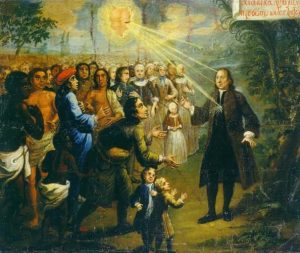
The Moravian Church (formally "Unitas Fratrum", or Unity of the Brethren), is one of the oldest Protestant denominations, predating the work of Martin Luther by about 100 years. It had its origins in Bohemia in Eastern Europe with the Hussite movement which was led by Jan Hus, who was burned at the stake as a heretic in 1415. Persecuted by the Catholic Church, they went underground in Moravia and eventually found protection with the German nobleman Count Nicolaus Ludwig von Zinzendorf (1700-1760), a religious and social reformer. Zinzendorf soon became the bishop of this new church and a Christian mission pioneer, transforming the Moravians into the first large-scale Protestant missionary movement. The northern headquarters of the North American Moravian Church is in Bethlehem, Pennsylvania, and the southern headquarters is in Winston-Salem, North Carolina.
There were several Moravian missionaries who lived and worked at Shekomeko during its brief existence, some longer than others, but these four are the most notable (see "The Moravian Mission at Shekomeko" page).
Christian Henry Rauch (1718-1763): Born in Bernburg, Anhalt-Berberg, Germany, Brother Rauch came to America in 1740. In 1742 he married Ann Elizabeth Robbins of Philadelphia. He was the first Moravian missionary to visit the Mahican village of Shekomeko. He died in Jamaica.
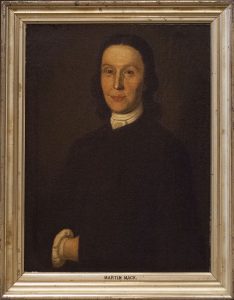
John Martin Mack (1715-1784): Born in Leysingen, Wuerttemberg, Germany, Brother Mack came to America in 1736 and died in St. Croix. He was one of the founders of Bethlehem, Pennsylvania. In 1742 he accepted a call from Christian Henry Rauch to become his assistant at Shekomeko. In the 1760s he began missionary work in the West Indies. He was consecrated bishop in 1770. He married three more times after his first wife Jeannette Rau died.
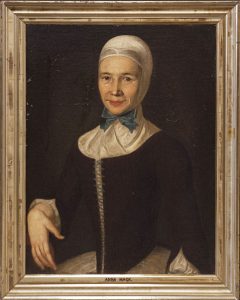
Jeannette Rau Mack (1722-1749): Born near Rhinebeck (on the "North River"), Jeannette was the daughter of Johannes Rau (John Rowe) who later settled near Halcyon Lake on the Little Nine Partners patent lands and befriended the Mahicans at Shekomeko, profiled above. She converted to the Moravian faith in 1741 and married Martin Mack in Bethlehem in 1742. She was fluent in the Mohawk and Delaware Indian languages and her contribution as a translator for the Moravians' missionary work among the Native Americans was immeasurable.
Gottlieb Büttner (1716-1745): Born in Silesia (a region of Central Europe located in Poland, the Czech Republic, and Germany), Brother Büttner came to America in 1741, and in 1742 married Margaret Bechtel, a Palatine living in Germantown. He died of tuberculosis at Shekomeko, aged only 29. The Moravian monument was dedicated to his memory.
Sources and Suggested Further Reading:
A History of the Beginnings of Moravian Work in America, The Rev. William N. Schwarze and the Rt. Rev. Samuel H. Gapp, The Archives of the Moravian Church, Bethlehem, Pennsylvania, 1955
"The Moravian Church", from Wikipedia
Little Nine Partners
There were nine partners but the three listed here, and their heirs, were probably the most important to the development of Pine Plains (see "The Little Nine Partners Patent", "Pine Plains Went to War", and "Slavery in Pine Plains" pages).
Augustine Graham (1672-1719) and his heirs: The earliest family of influence in Pine Plains was the Graham family, active in local politics, patriots in the Revolution, and, it should be noted, slave holders (as were many other northerners, from middle-class shopkeepers and tradesmen to wealthy landowners). Augustine Graham was the son of the Attorney General of the Province of New York, James Graham, and great-grandson of James Graham the Marquess of Montrose (executed in Scotland in 1650 for his support of the English monarchy against the Scottish Covenanters, a religious and political movement) he married Jane Chiswell and was one of the original patentees of the Little Nine Partners patent and Surveyor-General of New York.
Interestingly, in the October 19, 1700 minutes of the Council of New York, His Excellency William Lawrence stated that, in his opinion, Augustine Graham “is a man not to be depended on”, that he is "not fit to be sole Surveyor", and that he [Lawrence] “believes it for the King’s service and for that of the publick [sic], that there should be several Surveyors allowed, that are sober, honest men, and of good skill in the art of surveying”. Finding himself out of favor, Graham returned to England for a spell, and it appears that his position was indeed filled by more than one surveyor until he returned and resumed his duties until his death.
Augustine died before the deed of partition of the Little Nine, so his son James inherited his share of seven lots. However, James had no desire to live up in the boondocks so he stayed down on the farm in Morrisania Manor (the South Bronx today), the estate of the high profile Morris family which the Grahams had twice married into (James had married his first cousin Arabella Morris, daughter of Lewis Morris, First Lord of the Manor and First Provincial Governor of New Jersey), and turned his Little Nine lots into income-producing leaseholds. When he died in 1767, his children inherited these lots but unlike their father, at least six of them -- Augustine, Lewis, Morris, Charles, Isabella, and Arabella -- eventually settled here. They chose adjacent Lots 29 and 48 (the east side of Main Street north and south of the intersection where the hamlet of Pine Plains is now located) for themselves, yet most of them held off taking physical possession right away because the land was leased. Only Morris Graham, who was chief executor of his father's estate, settled here at this time. In 1773, the Graham lots were surveyed and subdivided into farms for James Graham's children. About half of the children later moved to Deerfield in Oneida County, New York, where they deceased.
Augustine (?-1815) was a lieutenant in the Revolutionary Army, and stayed in Pine Plains the longest of the siblings. Because of this, he eventually became the manager of all of the unsold and undivided Graham land in the patent and was involved in several litigation proceedings over property disputes. This led to financial difficulties. All of this is related in great detail in Isaac Huntting's history.
The stone house "Rock Gate" was built at the foot of Stissing Mountain on Graham Lot 27 in 1795 by Augustine Graham's son James. The land here had been used by Morris Graham during the Revolutionary War to drill his regiment. The building was torn down when the property was owned by Briarcliff Farms under Oakleigh Thorne.
Lewis (1743-abt. 1795) fled here around 1776 from his home in Morrisania to escape the British, settling on Lot 48 in what is now called the Graham-Brush House. He was a colonel in the Revolutionary Army and a member of the Provincial Convention of New York from Westchester. He was Supervisor of North East Precinct from 1779-1781 and again in 1784. Lewis married while living in Pine Plains and fathered a daughter Margaret. He returned to Westchester County after the war and became a judge there, and the 1790 federal census shows a Lewis Graham, Esquire living in the Town of Westchester with his family and eleven slaves. However, he continued to manage his northern holdings, contributing timber, for example, to build a bridge at Hoffman’s Mill in 1794. (see the "Graham-Brush House" page for more information about his house).
Lewis Graham's will:
Lewis Graham of Town of West Chester in the county of West Chester. Will 15 October, 1793; proved 19 December, 1800. All to daughter Margaret at 18 or marriage, except to friend Mrs. Margaret Skinner 100$. My faithful Negro Man Slave named George to be manumitted and estate charged with his support if he pecomes (sic) necessitous. Executors: Friends Egbert Benson, John Parkinson, and Thomas Hunt. Witnesses: Samuel Finley, John Burroughs, Peter Bloome. Westchester County Ss 13 December, 1793. Before Peter Bell, Surrogate. Oath of Samuel Finley of town of Westchester Physician. True Copy attest Peter Bell. At town of Pelham, same day, proved by Thomas Hunt and Egbert Benson. Proved in Prerogative Court of Canterbury, as will of Lewis Graham, late of Pelham in the county of Westchester in North America, by Erringham Lawrenee, Attorney for Egbert Benson and Thomas Hunt, two of the executors, living in New York in North America, John Parkinson, the other executor being first summoned and not appearing.
Charles was a captain in the Revolutionary Army and Town Clerk of North East from 1774-1775.
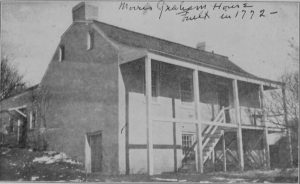
Morris (?-1805 or 1806) began construction in 1768 on the twenty-four by thirty-four foot stone house about two miles south of the Pine Plains hamlet on Lot 29, completing it in 1772. It was the first stone house built in the town and is the only one surviving from the colonial period, built with stone quarried from nearby land, with a gambrel roof (unusual for a stone house) and a corner fireplace. Morris was Town Clerk of Northeast Precinct from 1772-1773 and Supervisor in 1774. He was a colonel in the Revolutionary Army and a member of the Provincial Convention of New York from Dutchess County. He gave a large portion of his estate to the support of his regiment.
Isabella (1747-1829), whose husband Jonathan Landon was a prominent civil officer of Pine Plains until his death in 1815, took the east half of Lot 48.
Arabella (1750-1840) took the northwest part of Lot 48 which is now the hamlet of Patchins Mill.
Capt. Richard Sackett (1678-1746): The earliest white settler of Amenia (where he was classified as a yeoman, or freeholder), Sackett had previously lived in New York City where he was the proprietor of a malt house or brewery on what is now Cherry Street. In 1699 he married Marjory Slade and together they had several children, one of whom, John Sackett, later worked with his father in the patent land distributions. In 1706 Richard bought into the Little Nine Partners Patent. Around 1711, he was hired by Governor Hunter of New York to supervise the settling of the Palatines in the region and train them in the production of naval stores. Huntting says of Sackett that he "had better knowledge of the lands than any other member of the company" (i.e. the Little Nine partners) and that he was taken into the Little Nine partnership "from necessity to secure the lands between him and the Connecticut River". Otherwise, notes Huntting, "he might have been a troublesome hornet." Huntting surmises that Richard Sackett and Augustine Graham (the Surveyor-General) were the formulators of the boundaries of the Little Nine Partners Patent. It should be noted that Richard Sackett recognized the rights of the Shekomeko Mahicans to their land when he sold 300 acres in 1741 to John Tice Smith (see "The Hamlets" page).
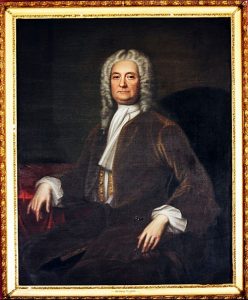
George Clarke (1676-1760) and his heirs: Some of the Little Nine partners were more wealthy and of a more aristocratic lineage than others. George Clarke definitely fell into the "more" category on both counts. Clarke was born in England and was appointed Secretary of the Province of New York, a position which Huntting feels prevented him from becoming a patentee when the Little Nine patent was granted in 1706, only buying in as a ninth partner years later. His marriage to Ann Hyde also put him in close relationship to the governor, Lord Cornbury, and with the Royal House of Stuart. He became Acting Governor in 1736 following the death of William Cosby and held that post until the arrival in 1743 of George Clinton to replace Cosby, was then Lieutenant Governor until 1747. Later, he sailed back to England, and on the voyage was taken prisoner by the French; they let him go but confiscated all of his money (one hundred thousand pounds), which Parliament repaid him. He never returned to America, dying in England, still a wealthy man. What makes George Clarke so important to the history of Pine Plains is not so much what he and his heirs did, but what they didn't do: his Lot 47 (which ran along the west side of today's Main Street), was passed down intact through six generations until 1895, the only Little Nine lot to remain undivided for so long and kept as leaseholds for that entire time. This prevented the development of this tract.
Sources and Suggested Further Reading:
History of the Little Nine Partners, by Isaac Huntting, Chas. Walsh & Co., Amenia, NY, 1897
The New York Genealogical and Biographical Record, Volume 37, 1906
The Sackett Family Association
Calendar of State Papers, Colonial Series, America and West Indies, 1700, edited by Cecil Headlam, M. A., London, 1910.
Slaves
Slaves, most only known to us by a first name if any name at all, contributed to the development of towns like Pine Plains in the North (see "Slavery in Pine Plains" page).
Innkeepers
Innkeepers in the colonial era and even into the 19th and early 20th centuries were often leaders in the community, and taverns and inns were the town halls and community centers of their day. Although there were other taverns and inns in Pine Plains (the first being the Stewart-Kellar House -- see "The Hamlets" page), the Stissing House and the Ketterer Hotel commanded the most attention and for the longest period, situated as they were on opposite corners in the center of the Pine Plains hamlet. Although the Ketterer Hotel is no more, the Stissing House is still in business, offering one of the finer restaurants in the region.
Stissing House
Cornelius Coenratse Elmendorf (1755-1826): A Revolutionary War veteran whose grandparents were from Holland, he married Rachael Cryspell in Hurley in 1778. He built the first hotel in Pine Plains on the Stissing House corner in 1782, and managed it for fifteen years. At the time it was a log tavern. The 1783 spring election for North East Precinct was held here, and town business was conducted here for many years. He later left the area, eventually settling in Kingston.
Dr. Israel Reynolds (1772-1824): He was the innkeeper of the Stissing House from 1806-1823. This was the first location of the Union Library of Pine Plains, the first public library in Duchess County. Reynolds was the third librarian of the library, the first postmaster of Pine Plains, and introduced the first mail route to Pine Plains. He was married to Deborah Dorr.
Henry C. Myers (1790-1870): Known as "Uncle Harry", he was the proprietor from 1835-1867, during which time it was called the Myers Hotel. During this period, cattle and sheep drovers from the west would stop here for the night, letting the animals graze on the inn's lawn. Henry was a popular landlord and was assisted by his wife Margaret and his three daughters. Isaac Huntting relates an amusing anecdote from the 1830s-1840s about the inn's sign, which hung from a post at the corner of the hotel and swayed at the mercy of the wind; he wonders if anyone then living in the village could ever forget the "doleful midnight creaking of that swinging board", which was "suggestive of the door to perdition on grated hinges turning".
Ketterer Hotel
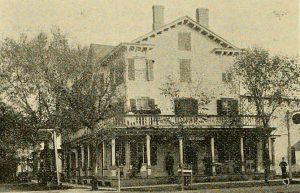
Dr. Asahel Haskins: He was the first proprietor, beginning in 1798. At this time it was a log tavern which sat on three acres on the southeast corner of Church and Main Streets, where the town park is today but extending further east and south. That same year Haskins became the town's first librarian.
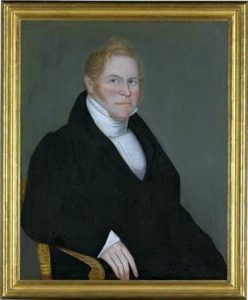
In 1804, the property was bought by Ebenezer Dibblee (1745-1826) and son Fyler Dibblee (1779-1841), who built the 2-story hotel on the site which was known then as Ebenezer Dibblee & Son. Ebenezer Dibblee married Ester Harvey in 1776; their daughter Sally who died in 1821 may have been the first burial in the original burying ground in the Pine Plains hamlet (later incorporated into Evergreen Cemetery). The Dibblees were the first Episcopalians in Pine Plains when they came here in 1784. Ebenezer also owned what was later called the Dibblee-Booth House, the former Indian trading post west of the hamlet (see "The Hamlets" and "Pine Plains Went to War" pages for more about this house). Fyler also became a shopkeeper in the building next door to the hotel, built around 1806 at a cost of $599.28 1/2 (see Bostwick below). Fyler was one of the early librarians of the Union Library and a town supervisor. A member of the Warren Lodge of Freemasons, he installed a "secret room" in the upper level of the hotel for the Masonic lodge. On December 30, 1820, a meeting was held in the hotel to appoint delegates to the county convention for choosing delegates to revise the state constitution in 1821; Fyler Dibblee was appointed one of the delegates to the county convention.
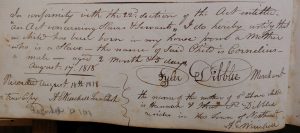 Fyler Dibblee was also a slave owner. Here is an 1818 account from the Town Records of North East (before Pine Plains was incorporated) of a child -- Cornelius -- born to a slave, Hannah, in the household of Fyler Dibblee, Merchant.
Fyler Dibblee was also a slave owner. Here is an 1818 account from the Town Records of North East (before Pine Plains was incorporated) of a child -- Cornelius -- born to a slave, Hannah, in the household of Fyler Dibblee, Merchant.
Click here for more information on this Act: An Act Relative to Slaves and Servants, 1817
Charles Ketterer (1828-1888) and son DeWitt C. (D. C.) Ketterer (1858-1914): They were the innkeepers consecutively for 42 years from 1872-1914. Charles, who was born in Germany and was a Civil War veteran, is said to have introduced beer to Pine Plains (that is, German lager since ales were already very familiar to Americans). He married Margaretha D. Mindline.
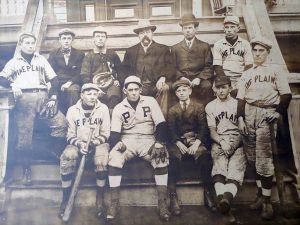
DeWitt Ketterer called his establishment The Pine Plains House while he was proprietor. He was married to the former Jennie Marie Boice.
The next owner of note was Mark Piester (1889-1966), a carpenter by trade. It became known as the Piester Building during his 45-year proprietorship (1921-1966), the longest of any innkeeper in Pine Plains.
Sources:
History of the Little Nine Partners, by Isaac Huntting, Chas. Walsh & Co., Amenia, NY, 1897
Physicians and Pharmacists
The field of medicine changed a great deal during the 19th century. The century began without any knowledge of germs and how they spread many diseases. Most doctors of this period still believed that illness happened when the classical humors (fire, earth, water, and air) in the body became out of balance, and the ancient practice of bloodletting to restore this balance continued to be a common treatment for most maladies. However, by the turn of the 20th century, there had been many advances in knowledge and technology, such as in the use of antiseptic surgical methods and the development of the x-ray.
Country doctors like those in Pine Plains rarely withheld services if a patient was unable to pay. Very often, payment might be in kind instead of with money, such as a cord of wood to heat the doctor's stove for the winter.
By the late 19th century, American drug stores and pharmacies had become retail establishments consisting of an upfront store where various sundries could be sold (and where most of the druggist’s income came from), sometimes a soda fountain, and a back room where the drugs were compounded and prescriptions filled. Originally, the druggist provided a more wholesale role while pharmacists were retail, but this distinction gradually disappeared and the two terms became interchangeable.
Some physicians practiced as pharmacists especially in rural areas, but this was becoming less common and physicians began writing prescriptions for pharmacists to fill.
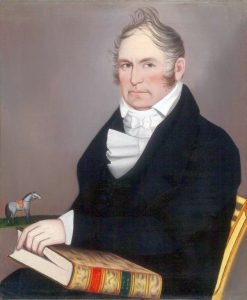
Dr. Cornelius Allerton (1779-1855): Dr. Allerton came to Pine Plains in 1810 and later married Clarissa Husted. He was among the first physicians to practice here and continued practicing until his death. Dr. Allerton provided the land for the Methodist Church and for Evergreen Cemetery. Huntting says of him that "his quick repartee and ever ready wit made him in his day the most conspicuous man in the town." His daughter, Miss Sarah Allerton, ran a select school in the Pine Plains hamlet for several years.
Dr. Benjamin S. Wilber (1795-1871) and son Dr. Henry Clay Wilber (1846-1919): Benjamin married Deborah Haight and settled on Halcyon Lake south of the Pine Plains hamlet (where Mashomack is today), where he farmed and began practicing medicine about 1825. He was instrumental in establishing the Methodist church in Pine Plains; his brother, Theron, was equally influential in establishing the Episcopal church in Pine Plains (see "Churches" page). Henry practiced medicine in Pine Plains for 52 years and for his service to the town the memorial clock was dedicated in 1920 (see "Wilber Memorial Clock Tower" page). Another of Benjamin's sons, Charles Seymour Wilber, was the publisher of the local paper, The Pine Plains Register (see The Newspaper Publishers below).
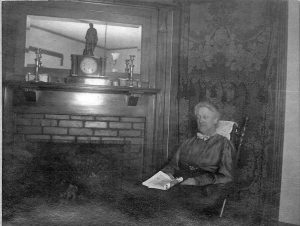
Clarissa Cole (1851-1932) and son Harrie Cole (1878-1951): Clarissa got into the pharmacy business when her husband, Dr. Charles Cole, became too ill from tuberculosis to continue his medical practice and switched over to pharmacy, then after he died aged 34, Clarissa took over the business, Cole's Drug Store. Initially, she was helped out by some local doctors but then she went to pharmacy school and got her certificate from the State Board of Pharmacy. This was unusual for a woman in the mid-1800s, particularly in a small, rural town. Clarissa also later became the town librarian and a switchboard operator. What is even more remarkable is that she did all of this from her home. Harrie became the town librarian as well and took over the pharmacy business from his mother. When Harrie died, the drug store had been in business for over 70 years.
Sources and Suggested Further Reading:
History of the Little Nine Partners, by Isaac Huntting, Chas. Walsh & Co., Amenia, NY, 1897
Melnick Medical Museum: "19th Century Doctors in the U.S."
"A Remedy for Every Ill", an article by Mike Bunn and Allen Vegotsky
Lawyers
Lawyers in early America were largely self-taught. A young man interested in a career in law might apprentice himself to an established lawyer for a period of time, but even as late as 1900 only about half of prospective lawyers had attended any law school and most were not even college graduates. Only the wealthiest Americans could afford that level of education and formal training.
The Eno Family: The Eno family was perhaps THE most influential Pine Plains family of the 19th century. Although most of them were lawyers by profession, they were also involved in many other aspects of community life.
Stephen Eno (1764-1854) was the patriarch of this family, originally from Simsbury, Connecticut. Largely self-taught, he came to Pine Plains in 1803 and set up his law practice on South Main Street. In 1795, he married Mary Denton of Amenia; after her death he married Olive Shores whom he outlived as well. His little law office, one of the last remaining free-standing law offices in New York State, was built in 1814 for $300. Stephen had quite a personal library and was the librarian of the Union Library from about 1804-1829. He was considered, in Huntting's words, the "life of the library".
Henry Eno (1798-1882), the oldest son of Stephen Eno. Although not as well known as others in the family and not a Pine Plains resident for half of his adult life, Henry is a fascinating character. Trained as a lawyer, Henry struggled early on with alcoholism before turning his life around and joining the Westward Movement in 1837, ending up in California. He was at different times a prospector, judge, newspaper editor, and a drifter. He returned home to Pine Plains in 1871, a physically and spiritually broken man. A collection of his letters have been published (see Sources below).
William Eno (1800-1874), another son of Stephen Eno. He was a Dutchess County legislator in 1836, Pine Plains Town Supervisor from 1844-45, and was appointed District Attorney for Dutchess County twice by the Justices of the Supreme Court.
William Stewart Eno (1827-1902) was a son of William Eno. He was the attorney of the Pine Plains Bank until the bank went into liquidation in 1857. After Stissing National Bank was organized, William became the attorney of that bank. When its president retired in 1863, William became president, an office he held until 1896. See more following.
The Pines and Evergreen Cemetery
In 1852 William S. Eno purchased a tract of land in the hamlet north of Church Street from Dr. Allerton, an heir of the original owner Peter Husted; included in the boundary of his purchase was the old town burial ground of about an acre first owned by the Union Meeting House. William laid out the southern portion of this tract into streets and lots for houses, and in 1878 he built his home, The Pines, on this tract. A mansion in the Stick-Eastlake style, it remains the grandest building in Pine Plains. At the time it was built it had many modern conveniences not yet found in the typical home, such as gas-operated fixtures and indoor plumbing.
The northern portion of the tract was laid out in plots and driveways for Evergreen Cemetery, which he would add onto twice more in his lifetime, encompassing fourteen acres. About 1880 he organized Bunnell & Eno Investment Company, being its first and only president. In 1895 he moved to Philadelphia when he relocated his firm's office there, and The Pines was converted into a tourist home run by William's sister-in-law, Rachael Rudd Eno. This was during the railroad’s heyday when it brought tourists from New York City to Pine Plains every weekend, and those tourists needed places to stay. In 1905 the Eno family lost the property after the investment firm's corruption was exposed. In 1983 The Pines was added to the National and State Registers of Historic Places.
Frank Eno (1845-1933) was the youngest son of William Eno. He wore many hats during his long life in Pine Plains: lawyer, dairy farmer, librarian, postmaster, and he served on the boards of both Seymour Smith Institute and Seymour Smith Academy for a total of 56 years. While he was the librarian, the library was forced to close; he saved it by changing it in 1874 from a membership library dependent on dues (the Union Library of Pine Plains) to a tax-supported free library, the Pine Plains Free Library. He was a member of the Stissing Lodge of Freemasons. At the time of his death he was one of the oldest living lawyers in the state and had practiced for over 60 years. His wife, Rachael Rudd Eno (1857-1941), was active in the women's rights movement. She was a delegate from Pine Plains to the suffrage convention of Dutchess and Putnam Counties held on May 8, 1915 at the Nelson House in Poughkeepsie, where she was elected a vice leader of the first assembly district. She was also secretary of the Dutchess County chapter of the WCTU (Woman's Christian Temperance Union).
When he was high-school age, Frank had the opportunity to visit the White House. Here is the letter that Frank Eno wrote to the New York Herald Tribune about that extraordinary visit.
To The New York Herald Tribune:
I note in Sunday's edition of The Herald Tribune an account of the sale by auction of the "identical" gold pen used by President Lincoln in signing the Emancipation Proclamation. Perhaps you may be interested to know the little that I recall in reference to it from the lips of the President. During the winter of 1863 I was a student at College Hill, Poughkeepsie, N.Y., with the son of Dr. Sunderland, then a noted Presbyterian minister in Washington. The doctor invited me to spend my holidays with his family. I accepted. A short time after New Year's Day the doctor started out to show us youngsters the sights, first taking in the White House. When we arrived at the White House we found the anteroom filled with army officers seeking interviews with the President: among them I distinctly recall General Thomas Francis Meagher, commander of the noted Irish Brigade. The doctor sent in his card and we were ushered at once into a large room used by the President as a reception room. When we passed in the room was empty, but soon an adjoining door opened and the President strode in, clothed very plainly and shod with what we used to call carpet slippers. He cordially shook hands with the doctor, and complimented him upon his last Sunday's sermon and remarked that one part of it reminded him of a lawyer he used to know in Illinois, and then proceeded to relate a very funny story, the gist of which has escaped from my memory. Not to take any more time than necessary, the doctor remarked to the President that "these two young fellows" would like to have his autograph. He reached across the table for a sheet of notepaper and wrote as follows:
"Executive Mansion, Washington, December 30, 1863. For Frank Eno. A. Lincoln."
After he had written it he remarked: "This reminds me that a short time after I had signed the Emancipation Proclamation some one wrote me for the pen with which I signed it, and I did not know what to do. You see that bunch of pens over there," pointing to a lot of penholders on the table, "Well, I reached over and picked out the best looking one, wrapped it up and sent it on."
This little incident would seem to jibe with what Senator Sumner is quoted as saying about a certain pen used by Mr. Lincoln. It certainly could not have been a gold pen. Dr. Sunderland, having free access to the floor of the Senate, took us down the aisle of the Senate Chamber afterward and introduced us to all the notables, tarrying only long enough with each to get the inevitable autograph.
I see now those intellectual giants as plainly as though it were only yesterday, among them the portly figure of Senator Sumner, with his iron gray hair, one lock falling over his forehead; old Ben Wade, tall and gaunt; the noble figure of Senator Wilson, the wiry little Gerrit Davis, the corpulent figure of Senator Salisbury, and Vice-President Hamlin, busily writing in the little room outside the Senate Chamber with time enough to greet us and scribble for each his autograph. Dr. Sunderland lived to a good old age, and officiated at the wedding of Grover Cleveland.
Frank Eno
Pine Plains, N.Y.
Jan.26, 1925
Sources and Suggested Further Reading:
History of the Little Nine Partners, by Isaac Huntting, Chas. Walsh & Co., Amenia, NY, 1897
"Early Lawyering in Colonial America", an article by Kristopher A. Nelson
Twenty Years on the Pacific Slope, ed. W. Turrentine Jackson, Yale University Press, 1965
Business People and Bankers
Banking in 19th century America was a risky venture indeed, with banks failing every few decades and plunging the country into the depths of depression. Although not as devastating as the "Great Depression" of the 1930s, these so-called financial panics sometimes lasted for years and left ruined lives in their wake. They could be caused by crop failures, wild railroad and land speculations, or sudden drops in the stock market. The economic problems and instability of this era were largely corrected by financial reforms that came with the progressive movement in the 20th century.
Reuben Walker Bostwick (1788-1861): In 1839 the Pine Plains Bank was organized with Reuben W. Bostwick as the first president, beginning a 123-yr. family association with this bank and its successors. Reuben started out in 1816 as a merchandising partner with his brother Charles B. Bostwick and Fyler Dibblee, selling dry goods in the shop next to the Ketterer Hotel. They also had a shop in Red Hook. While the partnership was dissolved in 1822, Reuben continued on with the shop in Pine Plains until 1859 (see photo of shop under subsequent proprietorship of Enos Chase on "The Hamlets" page). He was a postmaster for many years. He was also town clerk of North East at the time of Pine Plains' formation and helped with the transition process, becoming the first town clerk of the new town. He was married twice, to the former Mary Fratt who died at only 23, then to the former Harriet Dibble. His son (pictured) joined him in the shop.
Jacob Stall Bowman (1843-1911): Born in the town of Milan and trained as a mason and builder, Jacob served in Company C, 128th NYSV in the Civil War, and in 1866 married the former Julia Thorne of Pine Plains and settled here shortly thereafter. In 1876 he opened the Bowman Pharmacy on East Church Street which he continued until his death, with prescriptions handled by Dr. Henry Wilber.
In 1895, he built the Bowman Opera House on the northwest corner of Church and Main Streets. This lot had previously been leased Clarke land and had just opened up to development; the corner soon became known as the "Bowman Block" because of all the businesses here. In 1898, the Bowman Block caught fire and would have been destroyed if not for the newly organized fire company. Jacob served Pine Plains as supervisor, town clerk, and postmaster. He was a member of the Stissing Lodge of Freemasons and was involved in many other organizations. He married the former Eliza Weaver after his first wife died. A cousin, Albert Bowman (1820-1899), was proprietor of the Stissing House in the 1880s and the first to give it that name.
Samuel Deuel (1873-1949): Samuel Deuel was the first member of the Deuel family (see Farmers below) to leave the family farm and go into business. He was married to the former Nellie S. Dusinberre. Growing up in the hamlet of Bethel, he attended Seymour Smith Institute in Pine Plains. He started out with a small coal and feed business just west of the P&E RR where Factory Lane is today, and in 1908 he purchased an old roller skating rink nearby which he used for storage and apple barrel making. In 1918 he expanded his business when he moved the entire operation over to the lumber yard at the C.N.E. Railroad Crossing on South Main, which he purchased from Frank R. Bouton. He was also a large dealer in real estate. Active in the community, he was a charter member of the Pine Plains Grange, a director of Stissing National Bank, a member of the Stissing Lodge of Freemasons, president of the Pine Plains Board of Education, director of the Evergreen Cemetery Association, president of the Pine Plains Water Co., and director of Vassar Brothers Hospital in Poughkeepsie. During World War I, he was chairman of the War Savings Stamp Drive committee, and under his leadership Pine Plains was the first town in Dutchess County to exceed its quota in the drive.
Julia Duxbury Slingerland Jordan (1887-1976): Julia spent her summers growing up in the family home in Hammertown, while winters were spent in New York City where her father had his business office. Her first love was music; she studied under Madame Frieda De Gebele Ashforth and later performed and taught voice, and she was an early sponsor of the Tanglewood concerts. She took over the operation of the William B. Jordan Jr. Insurance Agency from her husband after his death in 1948 and ran it for 29 years. She was an organizer and second president of the local PTA, a vice president and honorary director of Stissing National Bank (where her husband had served as cashier for twenty-five years), a president and director of Evergreen Cemetery, honorary president of the Little Nine Partners Historical Society, member and vice president for Pine Plains of the Dutchess County Historical Society, and a life member of the Pine Plains Chapter of the Order of the Eastern Star. Her husband William B. Jordan Jr. (1885-1948) had also been very active in the community and had served as town clerk from 1911-1913. Their son Frederick A. "Fritz" Jordan (1910-1993) was a championship coach and inductee into the Dutchess County baseball and basketball halls of fame.
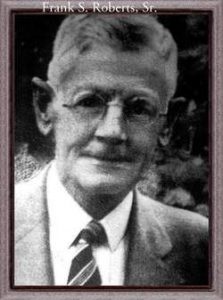
Frank Roberts (1870-1969): Before coming to Pine Plains, Roberts lived in Connecticut where he served 2 terms in the Connecticut state legislature. He married twice, to the former Flora Gaines and after she passed away to the former Nellie Hemingway. In 1917 he settled in Pine Plains when he bought the funeral home business here, which became Roberts' Funeral Home. He was a member of the Stissing Lodge of Freemasons. He retired from his business in 1950, at which time the funeral home came under the direction of C. Buel Peck of Copake, and later became Peck & Peck Funeral Home which is still in business today.
Sources and Suggested Further Reading:
History of the Little Nine Partners, by Isaac Huntting, Chas. Walsh & Co., Amenia, NY, 1897
"Financial Panics of the 19th Century", an article by Robert McNamara
Poughkeepsie Journal
The Pine Plains Register
Shopkeepers and Tradesmen
Dry Goods or General Store … which is it?
A hundred years ago, shopping for a household entailed multiple stops.
- Grocers, which sold produce
- Butchers (Meat Markets), which sold meats
- Bakeries, which sold baked goods
- Dry Goods Stores, which sold a variety of household non-food items, particularly textiles, sewing notions, and such, although not limited to these. Department Stores (also called Variety Stores) evolved from these.
- General Stores, which could sell nearly anything, although they generally didn't include stuff you'd find at the grocer or butcher.
(adapted from straightdope.com)
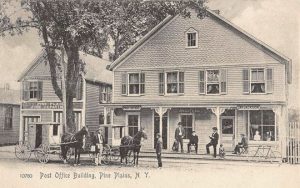
Jay Jackson (1843-1919) and son Harry Jackson (1882-1970): A watchmaker and jeweler, when Jay Jackson died he was eulogized as "the oldest businessman in Pine Plains" at 76 years old. Married to the former Martha Kilmer, Jay was at different times postmaster, newspaper owner, town assessor, and town clerk.
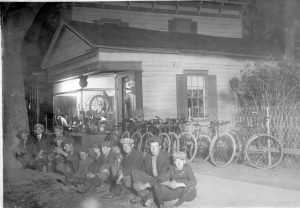
Harry, who continued in the same trade, was perhaps Pine Plains' first travel agent, promoting local tourism and taking photos of local scenes which were sold as postcards. He also sold sporting goods in his shop.
Peter S. Wolven (1850-1927): Peter came to Pine Plains in 1877 and established a meat market which he ran until 1914, a total of 37 years. He married the former Sarah Brink. It is said that he laid the first flagstone sidewalks in Pine Plains. Sometime before 1910, his son, Wilber E. Wolven (1885-1932), bought the Bowman Opera House and renamed it Wolven's Opera House; during his ownership, a soda fountain was installed downstairs. He was married to the former Emma Hoffman.
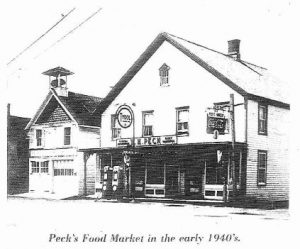
William M. Peck (1896-1983) and son Richard Peck (1919-2002): William, a purveyor of "fancy groceries", founded William M. Peck & Son grocery store in 1922. He served Pine Plains as supervisor and president of the water company. He married the former Mabel Brill. Son Richard, a WWII veteran who married Frances Bourland, continued the business which is still in the family, and was involved in many local organizations. Both men were members of the Stissing Lodge of Freemasons.
Isaiah Dibble (1828-1909) and brother Edward Dibble (1831-1908): Isaiah opened Dibble's Store, a dry goods business, in Pine Plains in 1865 and ran it with his brother, Edward. Isaiah was married to Eunice Thompson first, then after her death he married Emily Mygatt of Amenia, who also soon died. He bought the former Brush home (the Graham-Brush House today) in 1890 and when it was sold in 1946 it had been in the Dibble family for fifty-six years, longer than any other family. After his and Edward's deaths within a year of each other, Isaiah's son Gustavus took over running the store until 1923, making the business one of the longest in operation in Pine Plains at fifty-eight years. Isaiah was a member of the Stissing Lodge of Freemasons, and his grandfather, also Isaiah Dibble, had run a carding mill in the Bethel hamlet (see "Industries Along the Shekomeko" page).
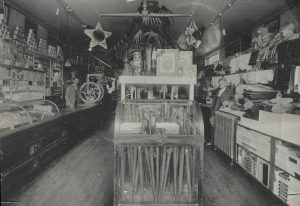
John W. Hedges (1864-1941): A 3-term supervisor and 4-term postmaster of Pine Plains (see "The Hamlets" page), as well as first president of the Pine Plains Hose Company, Hedges was also a member of the Stissing Lodge of Freemasons. He owned a successful department store in the Pine Plains hamlet and in 1913 became the first merchant in the hamlet to wire his business for electricity. He married the former Minnie Hapeman.
Silas Harris (1787-1862): Silas owned the Harris Scythe Works in Hammertown, one of the most important manufacturing businesses to the town through the early 19th century (see "Industries Along the Shekomkeo" page). He was a member of the Warren Lodge of Freemasons and an overseer of the poor. He married the former Maria Pugsley.
Peter Husted (1761-1808) and son Cornelius Husted (1789-1859): Peter owned the Cornelius and Peter Husted Tannery in Hammertown (see "Industries Along the Shekomeko" page). He was a town clerk and supervisor of the Town of North East (before Pine Plains separated to form a town), a founder and trustee of the Union Library of Pine Plains, a patron of a local district school, and a member of the Temple Lodge of Freemasons in Spencer's Corners. He owned a large tract of land in the Pine Plains hamlet north of Church Street which was where the original town burying ground was located and where the Union Meeting House was built. He was married to the former Polly Smith (see "The Hamlets" page). Their son Cornelius married the former Phebe T. Waters. He was one of the organizers and first directors of the Pine Plains Bank.
Sources:
History of the Little Nine Partners, by Isaac Huntting, Chas. Walsh & Co., Amenia, NY, 1897
The Newspaper Publishers
The 19th century was the heyday of the American newspaper. In rural areas like Pine Plains, people often subscribed to newspapers through their mail carrier, who in turn paid the printer; if the mail carrier didn't collect from the subscriber, it came out of his pocket. As roads were built and postal routes increased, the number of subscriptions increased, particularly for papers outside the local area. Papers that came through the mail were usually subscribed to through the postmaster and had postage added on which was the subscriber's responsibility to pay, but newspapers were subsidized by the federal government and given preferential postage rates. The government also did not tax newspapers or advertising, and publishers could send their papers to other publishers without postage. Called the exchange system, sort of like our AP wire today, this made news available to all publishers and was to a smaller newspaper's advantage. Such was the growth of the newspaper industry at that time that a small rural town such as Pine Plains could support two weeklies.
Samuel T. Hoag (1842-1938): Samuel became the publisher and editor in 1864 of The Pine Plains Herald and remained in that position for over 60 years, still using a hand-operated Washington printing press. He was called the “Dean of Dutchess County editors”. His wife was the former Mary Place.
Charles Seymour Wilber (1840-1925): Charles established The Pine Plains Register in 1882 and remained publisher until 1907. He was a brother of Dr. Henry C. Wilber (see Physicians above). When he died in his 85th year he was called the oldest newspaperman in Dutchess County and perhaps the entire Hudson Valley. In the spring of 1862, he enlisted in Co. M, 128th Regiment, NYV, and served until the end of the war, returning home in the summer of 1865. He was a member of the GAR, and for 14 years or more was president of the 128th N Y Regimental Association. He was a member of the Stissing Lodge of Freemasons and a local judge. He married the former Mary Kip, who sang in church choirs and performed in local amateur theatrical productions.
The two weeklies above were combined in 1926 as The Register-Herald by Gottfield Grant from Peekskill. After his death in 1936, the paper was published for many years by his son and daughter, Henry A. Grant (1906-1996) and Eda Grant Aroh (1902-1999).
Henry married the former Bernice Leach. He was a member of the Stissing Lodge of Freemasons and a charter member of the Little Nine Partners Historical Society, serving several terms as its president. He was a 50-year member of the Pine Plains Lions Club.
Eda was the founder of the Pine Plains Garden Club, a member of the Little Nine Partners Historical Society, a matron of the Pine Plains Chapter of the Order of the Eastern Star, and a trustee of Evergreen Cemetery. She married Lester C. Aroh.
Sources and Suggested Further Reading:
History of the Little Nine Partners, by Isaac Huntting, Chas. Walsh & Co., Amenia, NY, 1897
"The News Media and the Making of America: The Early Nineteenth-Century Newspaper Boom"
"Old Newspapers, New Perspectives on the American Revolution", an article by NPR staff
Farmers
Pine Plains developed as a rural community, and it remained largely rural into the 20th century. In the beginning, wheat production was predominant, but as the soils became depleted and the Erie Canal, which opened in 1825, created competition with western wheat markets, farmers in New York began to switch over to dairy farming.
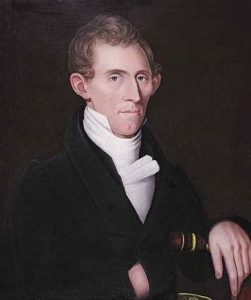
The Deuel Family of Bethel: Samuel Deuel (1805-1892) settled on Bockee land near the Bethel hamlet (where the giant sycamore tree is on County Rte. 83), having married Catherine Bockee, the daughter of Jacob Bockee, in Smithfield in 1825 (see inset). The Deuels were of Huguenot ancestry, the original family name being DeVille.
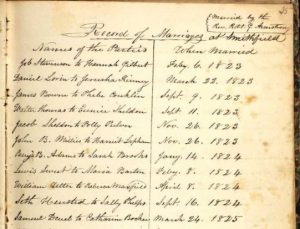
Besides farming his 350 acres, Samuel was active in the growing community, being the innkeeper of the Stissing House in 1824, an assessor, and one of the original seventeen directors of the Pine Plains Bank, and together with his youngest son Silas helped organize the ceremony for the Moravian Monument dedication in 1859. This portrait of him by Ammi Phillips shows a man of some importance. As further evidence of the wealth and influence of this early Pine Plains family, Samuel and Catherine commissioned Ammi Phillips to paint a portrait of their daughter, Mary.
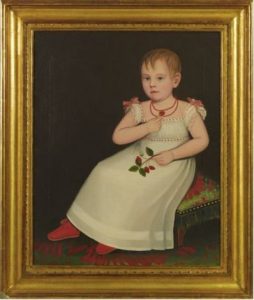
This farm was one of the many small farms that were purchased in 1907 in southern Pine Plains by Walter Law to become part of Briarcliff Farms. Around 1918, after Oakleigh Thorne took over ownership of Briarcliff, the Samuel Deuel homestead was dismantled.
Phoenix Newton Deuel (1830-1904) was a son of Samuel Deuel and the father of Samuel Deuel the businessman profiled above. He purchased the Morris Gray farm in Bethel, which John Tice Smith had purchased in 1749 from a Little Nine Partner assignee (see "The Hamlets" page for more information on the early history of this property). This farm also became part of Briarcliff Farms, but the historic house lasted until sometime in the 1990s, at which time it too met its demise when it was bulldozed by a subsequent owner.
Phoenix Deuel was a trustee of the Seymour Smith Institute in Pine Plains in 1871, where his son Samuel later went to school. As a resident of Bethel, he had a large influence in the life of that hamlet. He was the last postmaster here; the Bethel post office closed in 1904 after his death. His wife was the former Margaret Amelia Covey, who remained in Bethel for several years after her husband's death and taught Sunday School in the old Bethel Union Church.
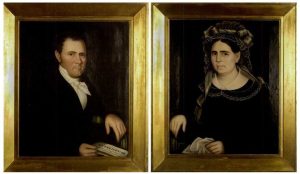
Robert Hoag (1790-1881) and his wife Phoebe Pugsley Hoag (1788-1859): The Hoags settled on Clarke land north of Hoffman's Mill in 1816. Robert was a distant cousin of Charles Hoag, the Quaker who lived in Bethel and established the meeting house and school there.
 In 1820, he received a certificate for growing the largest amount of corn on one acre in the county (see inset). The Hoags later left the area and settled in Amenia.
In 1820, he received a certificate for growing the largest amount of corn on one acre in the county (see inset). The Hoags later left the area and settled in Amenia.
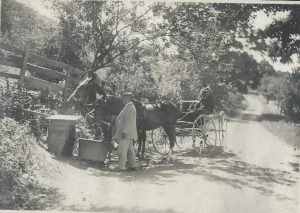
George Webster Tuttle (1866-1929): Born in Massachusetts, as a young man George went to sea on a mackerel schooner out of Glouchester, but owing to color blindness he was unable to get his Master Mariner license. Eventually, he got into the hotel business and worked his way up. He came to Briarcliff Manor in Westchester County and began working for Walter Law in 1905. Law brought him up to Pine Plains to manage Briarcliff Farms when Law moved that operation in 1907, and George simultaneously managed the Briarcliff Lodge resort back in Briarcliff Manor. George is credited with controlling bovine tuberculosis, which New York State had been unable to do. In Pine Plains, he founded the District Nursing Association, the Community Church Services, and the Men's Club, and he was a member of the Stissing Lodge of Freemasons. He was also a member of several clubs and organizations in Westchester County and elsewhere. He was married to the former Elizabeth Van Ostrand and after her death in 1902 he married M. Maude Mills. After Briarcliff Farms was sold to Oakleigh Thorne in 1918, George returned to Westchester County.
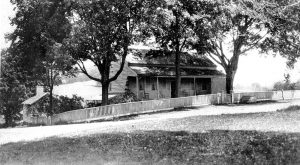
The Righters Family of Righters Corners: The Righters were Palatines (original name Richter). The first of this family to come to Pine Plains was Wilhelmus Richter (1748-?) who around 1787 settled on the northeast corner of the intersection of what is today Rte. 199 (the old Salisbury Turnpike), County Rte. 70 (or Righters Corners Road), and Rte. 82, just east of the hamlet of Hammertown. Wilhemus, who changed his name to William Righter, was a farmer and served as a Justice of the Peace.
John Righter (1820-1918): William's grandson, John, was a town supervisor of Pine Plains. When he died, he was deemed the oldest citizen of Pine Plains. His mother, Hannah Harris Righter, was a daughter of scythe-maker John Harris. His wife was the former Carolyn Ryder. His cousin, John Harris Righter (1848-1909), was a partner in the Selchow & Righter Company which developed the board game Parcheesi, however, although his parents were from Pine Plains, John Harris Righter was born and lived his whole life in New York City.
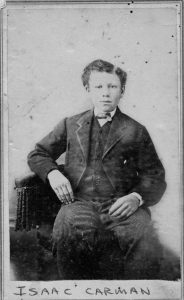
Isaac P. Carman (1853-1916): Isaac was the town supervisor of Pine Plains for several terms, superintendent of the poor for Dutchess County, a member of the Pine Plains Grange, and a member of the Stissing Lodge of Freemasons. He was married to the former Violet McClellan, the daughter of Scottish immigrants. He took over his grandfather George Smith's farm east of the hamlet of Bethel on the Pine Plains - Amenia Road (now County Rte. 83). The owner of this property before George Smith was a Quaker, Edmund Reynolds, who was also a scythe-maker with John Harris and then later in life made scythes for his own use on this farm. Probably the most interesting thing about this property is that in the 1880s and 1890s, Isaac Carman boarded Barnum & Bailey Circus show animals here. Isaac coordinated the wintering of these animals at various farms in the area. Among the animals boarded were ponies, zebras, and camels. The boarding fee was $5/month per animal, with a circus employee boarding with the farmer for $10/month.
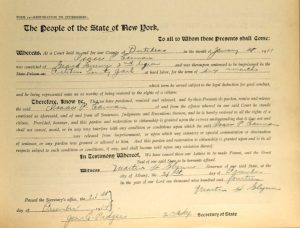
Unfortunately, Isaac got himself into a spot of legal trouble while he was county superintendent of the poor. In January of 1911 a grand jury indicted him on seven counts of misappropriation of funds and falsifying his books. He plead guilty to a charge of grand larceny in the 2nd degree, for which he was sentenced to six months in the county jail and a $500 fine. In commenting on the case the judge said, "Carman did what many other superintendents have done. He spent the money for the entertainment of visitors largely. This plea of guilty deprives him of his citizenship and loses him his franchise. To a man who has been a good citizen, this in itself is a severe punishment." In 1914, he was pardoned by the governor (see inset).
Israel Harris (1782-1831): Although he was a cousin of the Harrises who owned the scythe works, it seems that business did not interest Israel and he became a farmer instead. He was also very active in the community. He was appointed justice of the peace of the Town of North East in 1818 and Colonel in the 20th regiment of the New York State Militia at the same time. He was supervisor of the Town of North East and the first supervisor of Pine Plains in 1823, and supervisor of the poor board. He was an assemblyman in the New York State legislature from 1820-1821. He was instrumental in establishing the Union Meeting House in Pine Plains. He was a member of the Warren Lodge of Freemasons. He was married to the former Mary Barker.
Sources and Suggested Further Reading:
History of the Little Nine Partners, by Isaac Huntting, Chas. Walsh & Co., Amenia, NY, 1897
Hudson River Valley: "Nineteenth Century Wheat Production in Four New York State Regions," a paper by Andrea K. Zimmermann.
Neversink Museum: "The Railroads Change the Dairy Industry". Although this is written about Orange County in New York, it could as easily be about Dutchess County and Pine Plains.
Patterson Weekly News January 26 and February 2, 1911.
Others
Seymour Smith: benefactor of the Seymour Smith Institute (later Academy, see "Seymour Smith Academy" page).
Isaac Huntting (1825-1910): Isaac spent his childhood on the family farm of his father, Edward, in the hamlet of Bethel. He had a superior education for a farm youth, attending various boarding schools in the region (called academies in those days), and was musical like the rest of his family. He traveled a good deal as a young man, spending some time in Texas, then in Michigan. While he was in Michigan, the Civil War broke out and he enlisted in the Union Army, attaining the rank of Major. In 1870 he returned to Pine Plains. It was after his return that he began his research on the history of the area, eventually publishing in 1897 his definitive history of the Little Nine Partners Patent, for which he is most remembered to this day. He was married twice, first to the former Nancy Cutler, and then to the former Anna Lockwood. He was a member of the Stissing Lodge of Freemasons and a member of the Pine Plains Grange, and frequently contributed articles to the local papers. In early 1910 he retired to Florida where he had purchased ten acres, and died there before the year was out.
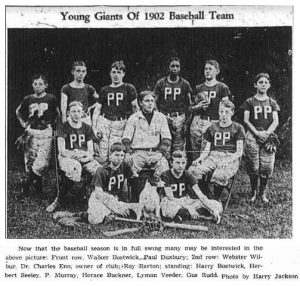
Horace Buckner (ca. 1830-1902): Horace Buckner was a freed Southern slave who was beloved in the community and known for his inspiring prayers at prayer meetings, and often times subbed for the minister of the Methodist Church. Horace was born in Virginia around 1830 (although one source has his birthplace as Kentucky), and he was the slave of either Aylett Buckner of Kentucky or his son, Simon Bolivar Buckner (a Confederate General in the Civil War and later governor of Kentucky), and that was how he got his surname. In 1864 there was an effort by the federal (Union) government to recruit and enlist slaves in Kentucky, and perhaps this is how Horace joined the 6th U.S. Colored Calvary (see "Pine Plains Went to War" page). Captain Benjamin Smith of the 2nd Michigan Calvary (later Lieutenant Colonel) befriended him and when Smith moved to Pine Plains after the war, Horace came with him. Smith became a farmer here and Horace worked for him. In 1865 Horace married Artemis Johnson in Pine Plains. In 1882, he was appointed chairman of Pine Plains School District No. 2 near Halcyon Lake.
According to a story in the Pine Plains Register of March 22, 1889, Horace had been separated from his first wife and two young daughters when they were sold off; after he came to Pine Plains he tried to find out what had become of his family, and he began writing letters to clergymen in St. Louis, Missouri. In fact, wanted notices appeared in newspapers all over the South after the war, as former slaves tried to track down loved ones separated from them by war, slavery, and emancipation. The result of Buckner's search, the story continues, was that one of his daughters, now a married woman, had been found. The article goes on to say that she was coming to Pine Plains to see her father, after a separation of 27 years. It is not known if the anticipated reunion happened, but in 1892 a collection by the community was done to finance a trip for Horace to Missouri.
The Bowman Opera House used to hold annual cake walks every July 5 and it is said that Josephine Buckner, one of Horace's and Artemis' daughters, usually carried off the top prize.
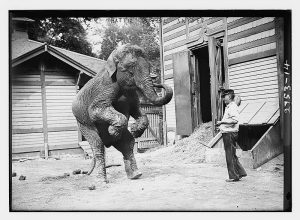
William Snyder (1864-1934): Bill Snyder was a head keeper at the Central Park Zoo, previously having worked as an elephant trainer for Ringling Bros. and Barnum & Bailey Circus. His wife was the former Anna Giering. He was born on the family farm in Pine Plains. Pine Plains actually had a long connection with the circus, being one of the communities where Barnum & Bailey show stock were boarded over the winter. Bill's cousin was a tent man in the horse department with Barnum & Bailey, and as a child Bill dreamed of joining the circus and being a bareback rider, down to wearing red tights and spangles. Although Bill practiced riding long and hard on the farm (without his father's knowledge), his cousin would not help him get a circus job. However Bill's older brother did join the circus as a tent man. When the brother got married and gave up circus life, Bill took his place. That was around 1883.
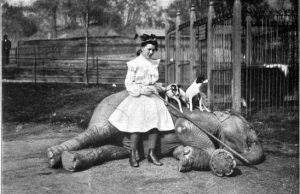
Bill eventually got a position in the elephant department and became renowned in the business as an elephant trainer, then left the circus to work at the zoo. After he retired, he came back to Pine Plains where he lived the remainder of his days.
Lyman Henry Hoysradt (1848-1933): Lyman first became interested in botany when, as a young man, a doctor advised him to spend more time outdoors as a way to cure what was thought to be tuberculosis. He went on walks all over searching out the rarest flowers and plants, starting in Pine Plains and eventually going south to New Jersey and throughout New England in his explorations. The result was the beginnings of a collection of pressed plants, called a herbarium. After Lyman’s death, the family donated what became known as the “Hoysradt Herbarium” to Hartwick College in Oneonta, New York where it is still housed in the Miller Science Building and made available for study and loan. It contains over 20,000 specimens. Lyman’s formal education ended after the eighth grade, but a love of learning drove him to educate himself. Although self-taught, he was highly respected by the academic world. He became a professor of mathematics and natural sciences at Seymour Smith Institute, where he met his future wife, Grace Hudson See, who was one of his students. Later, he taught for many years, until his retirement, at the Old Grove Street School in New York City. It was after his retirement from teaching that Lyman turned his attention to the gardens at his home on South Main Street in Pine Plains, and from there his interest in peonies developed. His nursery, called Maplewilde Peony Gardens, soon opened for tours and attracted people from all over, even the likes of society ladies Mrs. Vincent Astor, Mrs. Oakleigh Thorne, and Mrs. Andrew Carnegie.
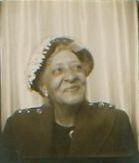
Anna Belle DuBois Young (ca. 1870-1964): Anna Belle Dubois Young had a difficult early life. Born into abject poverty, the child of a domestic servant and her employer, Anna learned to cope with life’s frailties by developing a great sense of humor. When she was growing up there were few respectable options for a single woman of color: domestic service, factory work, or marriage, and in those days black single women far outnumbered black single men in New York City, so finding a husband was almost impossible. Anna and her sister Rose both became domestic servants, but with the influx of European immigrants after the turn of the 20th century, the well-to-do households hired them for the better positions and black women were left with the less-desirable jobs of cook, charwoman, and laundress. Anna escaped from this life of drudgery for a few years after she married a William Young from Virginia, who was a barber then a steward in a fancy club. They took in and raised Rose's daughter, Laura, after Rose died. Laura would go on to marry Irving Jackson in Pine Plains and become the matron of that well-known family. After William died, Anna returned to a life of domestic service in Scarsdale, New York, spending her summers in Pine Plains with her niece's family. Eventually, she retired to Pine Plains, where she was an eccentric but beloved local character.
Sources and Suggested Further Reading:
The Pine Plains Register
Harper's Round Table, Vol. 13: "The Story of an Elephant Trainer", by Benjamin Northrop, 1891
St. Nicholas: An Illustrated Magazine for Young Folks, Volume 32: "A Girl Who Trains an Elephant", by John C. Rogers, 1904
The Jackson family
“Valuing Domestic Work”, by Premilla Nadasen and Tiffany Williams, Barnard Center for Research on Women.


